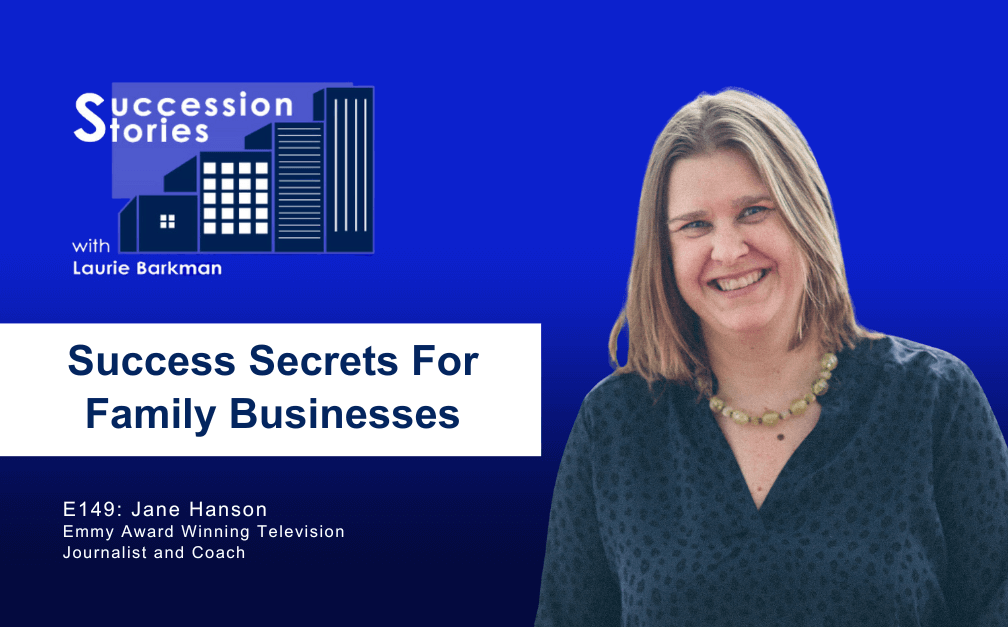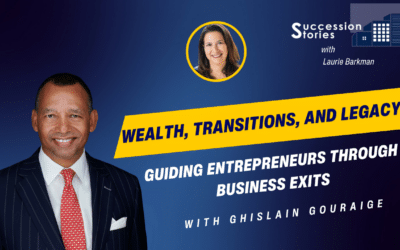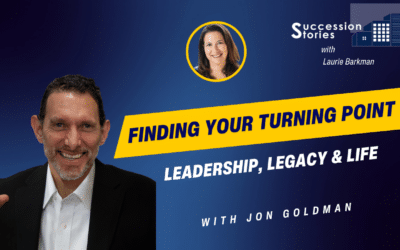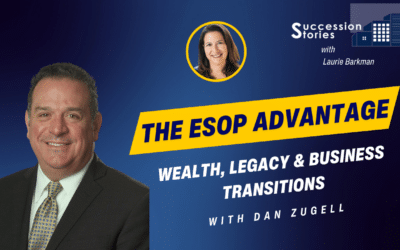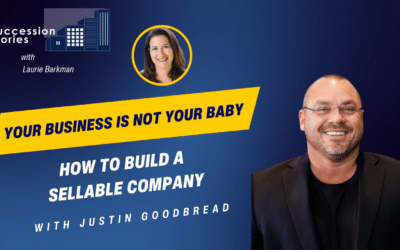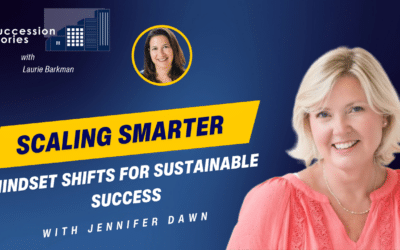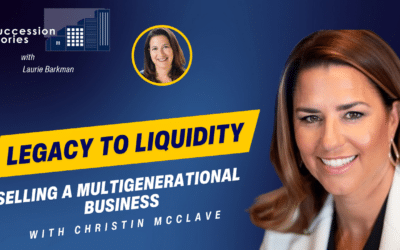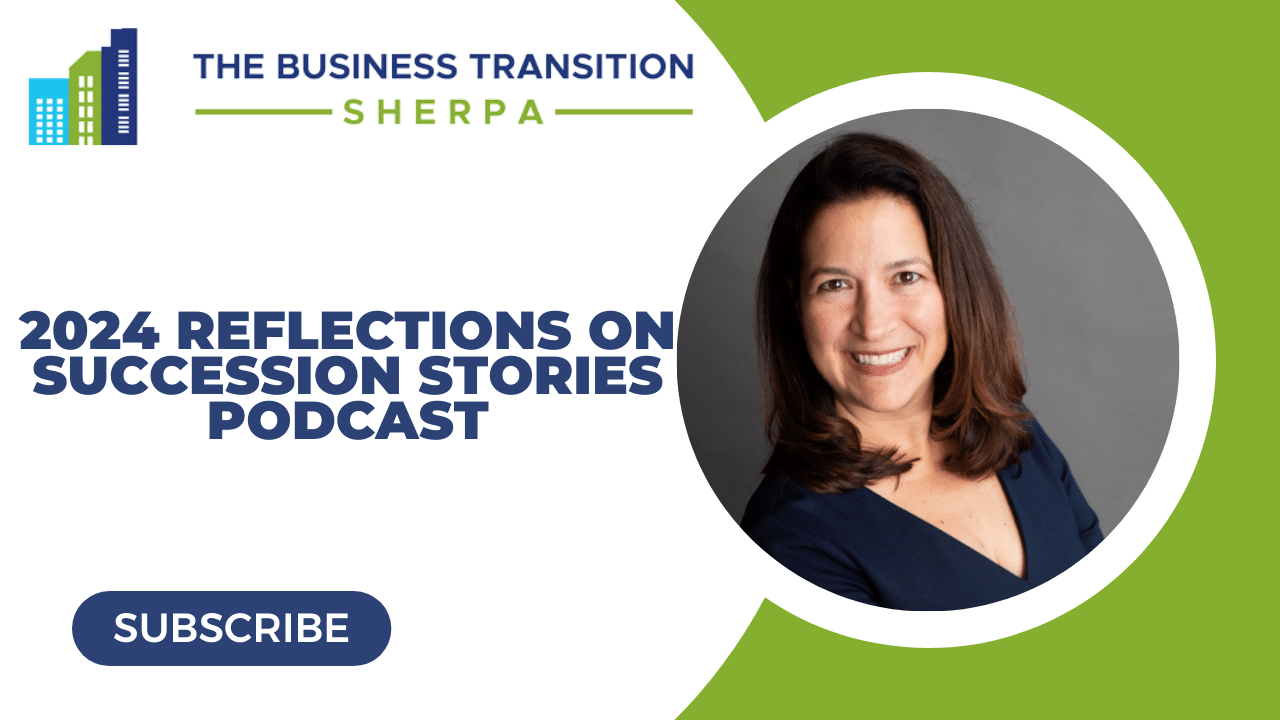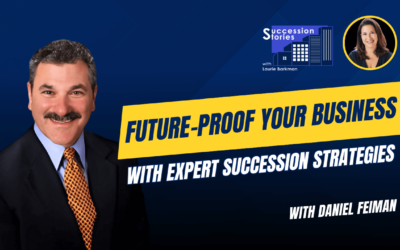Succession Stories host Laurie Barkman, The Business Transition SherpaⓇ, is joined by Meghan Lynch, the driving force behind Six-Point Creative, a marketing services firm dedicated to empowering family-owned and closely-held businesses. Meghan’s mission is to help family businesses compete against industry giants.
Listen in as they explore:
- The challenges that family businesses face in balancing sustainability and growth
- Strategies for family businesses to achieve 2X growth while maintaining control over relationships, messaging, and future direction
- 3 essential steps for family-held businesses to achieve their goals in the coming year and beyond
Enjoy this Succession Stories episode about how family businesses navigate growth crossroads with Meghan Lynch.
Find Meghan Here: https://sixpointcreative.com/
❤️ Show us the love on Rate This Podcast: https://ratethispodcast.com/successionstories
_______________________________________
SIGN-UP FOR OUR NEW MASTERCLASS
TO MAXIMIZE VALUE AND EXIT ON YOUR TERMS:
“Endgame Entrepreneurship: Build With The Exit In Mind”
_______________________________________
Embark on a journey of understanding and practical application as we navigate the realms of building a scalable business, unveiling the potential for growth and empowerment. Unlock deeper insights into the transformative realm of entrepreneurship and scalability by engaging with us through various social media platforms:
My Links:
🌐 Website: https://TheBusinessTransitionSherpa.com
⏰️ Meet With Laurie: https://thebusinesstransitionsherpa.com/connect/
🎙 Podcast: https://podfollow.com/succession-stories
🎥 YouTube: https://www.youtube.com/@TheBusinessTransitionSherpa
😎 Instagram: https://www.instagram.com/lauriebarkman/
✖️ Twitter: https://twitter.com/LaurieBarkman
😺 TikTok: https://www.tiktok.com/@businesstransitionsherpa
_______________________________________
📘 THE BUSINESS TRANSITION HANDBOOK:
Get a free digital copy of “The Business Transition Handbook” by author Laurie Barkman:
https://thebusinesstransitionhandbook.com
SHOW TRANSCRIPT:
Laurie Barkman
Meghan Lynch, welcome to Succession Stories. We met at the Cornell Family Business Conference not too long ago and here we are meeting again on Zoom. Welcome!
Meghan Lynch
Thank you so much, Laurie. I’m really happy to be here!
Laurie Barkman
It was a great conference, don’t you think? I learned a lot. What were some of the most surprising things that you found from that conference?
Meghan Lynch
Oh, there were so many of them. It was like jam-packed with insights. I feel like a few of my big takeaways, things that I keep telling other people whenever I get a chance, is thy they talked about a study that their PhD program was doing on the effect of education on the success of family businesses. One of the big takeaways from the findings was a little bit counterintuitive, where they found that for family businesses, especially families who have really high involvement in the businesses themselves, education could actually be counterproductive. It could actually produce negative outcomes if you didn’t also take into account the family system along with the business system and kind of business best practices. That to me, I was, even during the conference, I was like slacking my team being, this is why we exist. Yes, this is what we bet. I know kind of felt from a gut standpoint, but then to see it in data and graphs, and have somebody studying it was really exciting to me. That’s something that I’ve been really trying to talk to people about is that these are two different systems that both need their own attention, care, and expertise. I think that was really exciting to me.
Laurie Barkman
I love that you and I met you there, it was after one of the panels that I had been on. We kind of just clicked in on how family businesses can think about their evolution, especially if they want to continue in the future. I was fascinated by what you’re doing.
I want to start with you and your story and how you got into supporting family businesses through creative storytelling and the other support you do through your agency. Why family business? Tell me your background there.
Meghan Lynch
My family is not a family business. I’m kind of unique in the space in some ways, just because I don’t come from a family business background where I think a lot of family business advisors do. Somebody the other day, and it may have even been when we were talking after the conference, my father is an Episcopal priest, and I was a priest kid growing up. As I look back, I’m kind of like, he was kind of the CEO of the parish. I kind of learned a lot of leadership skills and got involved there. But he was a priest, my mom was a teacher, business was not really something that was spoken in our house–very foreign concept to what we were doing but I thought I was going to be a teacher, like a college professor. I would I have a master’s in English literature that I have yet to deploy.
While I was in graduate school, I started working in a marketing agency doing work there. I just really started liking my day job more than I was liking academia. It was almost like more corporate than corporate, like all the things that I thought I was gonna love to do, have amazing conversations with people about books, and just read all the time. That was not really what it was like at all. I kind of switched gears and ended up going deeper into marketing, and worked in an agency where I met the two partners and we founded Six Point. That was kind of the short form, but got into family business when they started talking about their retirement because they were kind of on the tail end of their career. I was on the beginning of mine when we started the company.
When they started talking about retirement and kind of winding down and I was going, Oh, I’m just getting started, I realized that we kind of had a succession issue. I reached out to a family business center locally and joined even though we weren’t technically a family business, but a lot of the conversations that they were having really simple or similar to what we were going through. The more time I spent with that group, the more I was just like, Oh, these are my people. This is the kind of business that I love. It just kind of went from there.
Laurie Barkman
You teed it up so I have to ask, because this, the title of the show, of course, is Succession Stories. Tell me a little bit more about the succession with your partners. How did you manage that?
Meghan Lynch
Well, I think how did we manage it? I would say, overall, it was a process that luckily they were able to let me know, probably three to five years before they were truly thinking about retiring, that they were thinking about retiring. I had time to let the initial wave of panic subside, gather myself, and start to look for resources to figure out how we make this successful.
I think my biggest concern was that the two of them were really the major doers and relationship holders in the business, I was much more behind the scenes, running the business operation so the idea of like, Oh, my gosh, they’re leaving, is all this just going to go away? What’s going to happen? And then also, knowing that how the business of the three of us is not going to be exactly the same as the one when it’s just me because they brought skills that I don’t have. They brought perspective that I don’t have. “What would the business be like when they left?” was sort of a big open question.
There was a lot of trial and error and mistakes along the way with the transition. Now that we’re kind of firmly on the other side, I feel really excited about the future. We are definitely not the same company. All it becomes one of those, like, if you change every board and the ship, is it still the same ship? We’re still technically Six Point but it’s a really different company than it was, you know, 10-15 years ago, for sure.
Laurie Barkman
Well, a couple of key points there. One, they gave you three to five years notice, which is great, better than two months of Hey, I’m retiring in two months and you got to figure this out on your own? Did you end up buying them out?
Meghan Lynch
Yes, I ended up buying them out of the company. We worked with an advisor who was really great about taking time to talk with us individually about what are all our individual needs, as well as what is our collective goal for the business itself. I think one of the things that came out in that was that both David and Marsha were really committed to having the company survive the transition. That was once we finished working with him, his big takeaway was, Hey, all three of you really want this to be successful and to carry forward that nobody’s in it to get as much as they can out of the business and forget about what happens after but that everybody kind of has longevity and succession truly in mind. I think the fact that that was the case and that we could kind of state that and put that at the center of the work is how do we make sure that this last was a really important piece of it. Because I think it was something that we could always come back to when we had to make difficult decisions–talk about buyouts and legal agreements and things like that. Centering that in the work was really important.
Laurie Barkman
That’s a really interesting backdrop to what you’re doing with the agency and working with family businesses. You’re not coming from one, but you have the sensitivity of some of the transition issues that family businesses face. Likewise, you are helping them with a sustainable future, which was something that was important to you and your partners.
Let’s switch gears and talk about that. What prompts a visit to your door? What is on the mind of the client that helps you say to them, yeah, I can help you. What are they churning on?
Meghan Lynch
There are usually a few key events. We identified six; six evolution points that family businesses go through that do kind of bring them to our doorstep. Overall, there’s this simultaneous feeling of opportunity, like we see the future, we see kind of the sense of like, there’s something exciting that could be, but also just this stuck feeling of just not understanding how to get from where we are to kind of that, like an inkling of that future that we have.
Things like next-generation transitions, entering a new market or channel, like seeing an opportunity, or like we can grow this company in that market but we don’t know those customers, we don’t have relationships. All the things that made us successful where we are, we don’t have that in this new space. It creates this scary feeling of just being stuck and being worried that if I make the wrong move, I’m going to actually move us backward. I don’t know exactly what the right move is and so lack of confidence. Especially in a business where they are used to being confident, they really know their existing customers, they really know their existing business, and so the sense of loss of control or loss of clarity is a new feeling for them.
Laurie Barkman
Do you think it’s a feeling of market disruption, in some cases, where the giant is moving in and taking over, whether it’s geography literally, or in the case of a global product or a product that’s nationwide, where there’s just a new technology or something disrupting the way they’ve always done things?
Meghan Lynch
Sometimes there’ll be a sense of that disruption. Oftentimes, it’s much more of a positive sense of we see a way that we could be the disrupter, that we could provide value in a different space to a different customer segment, in a different way than we’ve done before. I think, most often, that’s kind of what’s driving. It is a sense of abundance of opportunity, but just no way to tap into it.
Laurie Barkman
There’s this growth mindset, there’s a sense of “we can do more”, they need some clarity and structure and execution assistance around how do we do that? Let me ask you, how do you help them do that? How do you prioritize growth opportunities? It’s a really strategic challenge.
Meghan Lynch
It is. I mean, a lot of what we do, I mean, again, I come from a family of educators, I wanted to be a teacher. I come at everything from the lens of education and I think it was one of the reasons why the Cornell study spoke to me so much is that we always start our engagements with workshops with their leadership teams, really bringing cross-functional teams and different perspectives and ways of looking at the business together in a room, and really, truly try to get clear about exactly what this opportunity is and what it can mean for the business. Again, when they come to us, they have a sense of opportunity, or even, maybe one or two people on the team see the opportunity, but other people aren’t quite on board for what it could mean or don’t quite see it the same way. Really working with them to get clear on what that future could look like, and really try to also get clear on what they don’t know, what are those things that are stopping them from moving forward? Because having the right data and asking the right questions is like nine-tenths of the battle. As soon as they start to get that data then the path forward becomes a lot, almost self-evident. But a lot of times, they’re used to making gut-level decisions without the data and changing that mindset and trying to bring in market data, trying to bring in customer voice of the customer interviews, things that can start to give more texture and nuance to the decision and start to make it clear what success looks like and also where the potential failure points might be.
Laurie Barkman
Generalizing a little bit here, but do you work mostly with Gen Two, Gen Three, Gen One; who do you tend to work with here on these projects?
Meghan Lynch
It’s usually a mixture. There’s often multiple generations in the room. Oftentimes, we become a helpful mediator or translator between Gen One, Gen Two, or Gen Two and Gen Three. But I think I’ve seen a trend in next gens, sort of stepping into family businesses, and identifying brand strategy and positioning as being something that needs attention in the company in a way that I hadn’t really seen in previous generations.
I think that there’s definitely a trend that the incoming generation is a lot more kind of like brand native, they understand branding as a concept, they understand it as valuable. Whereas previous generations will sometimes balk at the idea of branding that it feels disingenuous or marketing feels sleazy, or that it’s more about build it and they will come if we just really do a good job, and we’re true to our word. That’s where our value is created. The incoming generation has more of a sense of, if we don’t tell our story, other people are going to tell it for us, so we need to. If we can’t control it, at least we need to influence what that story is.
Laurie Barkman
Do you see a difference in companies that have their name on the door versus not?
Meghan Lynch
It definitely means that the decisions around the brand when the name is on the door, tend to become more emotionally fraught. There’s a sense of less separation between us and our identity and the business itself, but it’s even harder to get that space. That said, we also do see from a customer relationship, how invested customers feel in the business and how close they feel to the business, really making family business part of the brand is whether it’s directly through naming or whether it’s through storytelling or things like that. That it does definitely have a positive overall effect on how people view the brand and and how loyal they feel to it.
Laurie Barkman
One example that I’m sure you have some two, I’ll share one from a much earlier episode. I think it was in the low digits, I want to say episode nine on my show, and it was Uncle Charlie’s Sausage was the brand. There actually was no Uncle Charlie. So that was a little secret to the brand, but they created an iconic character that was identified with the product. The person who came on my show is Len Carrick, he had bought the company and they had revamped the brand. When they wanted to update the logo and the character, it was a really big deal; which pictures to choose. Of course, there was no real Uncle Charlie, but they felt like it was a really important thing and got feedback from customers and they did it the right way. It was successful. Do you have any examples where things went well in a rebranding with a family name or things where it went wrong that you might share with us?
Meghan Lynch
I think some of the places where we’ve seen it go well are where we’ve seen companies take a very almost like surgical approach to change because I think sometimes in examples like the one that you gave there, especially when you buy the company or whatever, you can feel like, Oh, there’s opportunity in this brand, we need to do a rebrand and that means like change everything.
We’ve seen several times, we’re actually making little tiny changes but making sure that the bulk of the brand identity does not change. One of our clients is a tool manufacturer, Hyde Tools, and they have these like black and silver tools that are they’re like guaranteed “forever lifetime tools” and they have a black handle with like an oval logo that like people will have in their grandfather’s toolbox, like you see these like old paint scrapers. We first came to to rebrand their company and one of the things that we did was look at the different places where equity was in the brand. That handle, that oval, but colors, the black and silver was one of the biggest sources of equity of their brand. The actual logo of the company had turned into a blue and red sort of rectangle piece. What we ended up doing was taking the logo from the handle of the tool, which was where most customers had their touch point, and making that the logo of the company, as opposed to completely changing everything. It was more an excavation stub like, okay, we’re not going to change it but instead, we’re going to make it more consistent and we’re going to pull out the piece that has the most equity and use that consistently across the company. They had multiple brand names and things that couldn’t have evolved over the years that had sort of diluted the brand. Instead, we kind of concentrated it and it was more about taking things away than changing or adding if that makes sense.
Laurie Barkman
I think the notion of brand equity in a name is really strong to think about for a family business. When we were attending the conference and I know you and I had talked about this off-air, there was a gentleman who was from the Watson Foundation. If you’re listening and you’re wondering, Watson, that sounds familiar. What did I know that from? It’s from IBM, the Watson family was, I don’t know if it was the Watson or they were other partners in the founding as well. But Watson was certainly a significant part of IBM, Mr. Watson and the Watson family had decided to maintain the name and the rights to the name. If you think of IBM Watson, that is a licensing agreement that IBM has with the Watson Foundation to use that name for I think it’s an artificial intelligence database and product that they’ve created, which that just struck me as so astute and aware of the value of the name. Good for them for thinking of it in terms of a business asset.
Meghan Lynch
That’s another story from that conference that I’ve been telling everybody. I was like, Oh, this was such a brilliant thing to do, to get ahead of it and protect it and see, again, the value of a name as being important. It’s not just the name, but it’s the trust that people associate with the name and the family and that reputation that they had built over decades. Seeing that as an asset and thinking creatively about how to protect it. Also, the other thing that I thought was really interesting is that it basically made them separate the Watson family name as an asset away from the IBM company that the family trust was an asset within the IBM company, and that they could kind of take that out, I thought was a really interesting idea now that it’s no longer family-owned. It’s kind of one of those stories that are filed away as a potential solution because if there’s one thing I think that family businesses are really good at, it’s about finding, like a third way or a fourth way that this is how it’s done in industries, or this is what how ways that companies solve problems.
Family businesses will say, I don’t want any of those, I want a different, new solution for this that is aligned with my values or takes into account our community or takes into account my customers or my employees. They do not like to let those things go. I think the fun thing is that it allows for really creative problem-solving, with lots of families coming up with that solution. It’s one of the reasons why we like doing this work is that it sort of forces you to be more creative because you often have guardrails, or constraints put on how you can solve problems that you might not have. If you were at a more publicly traded company, where it was like, Hey, the fastest path to the bottom line is what you’re gonna do with family businesses, things are just more complex. It’s not just about what’s going to make us the most money or how we increase returns this quarter, but it’s thinking about how is the community going to react, what are our customers going to think, what about our supplier relationships, all of those pieces.
Laurie Barkman
Absolutely. If I ask you for the three big things, what are those three big things that you think any family business should consider in the next six to nine months as they approach the next calendar year? What are those big things that they should be working on to preserve their strategic growth?
Meghan Lynch
I think the first is to truly start thinking about their brand as an asset within the company that needs its own protection and care. You had a great episode a few weeks ago with Heather Pierce Campbell, who is talking about legally protecting and different ways that you can look at value creation with your company. I guess first of all, what do people need to listen to that episode because I think she had a lot of really great creative ways that you can think about where your value is created. Often when I’m talking to family businesses, they’ll say, Oh, brand, that’s not really needed in our industry, or that’s not relevant to us. But if I exchange the word brand with the word reputation, they’ll be like, Oh, our reputation, that’s the most important asset we have. If it helps, you substitute the word brand with the word reputation and think about how you’re going to protect your reputation, how you’re going to amplify your reputation, and really be thinking about it as an area where you need to do strategic planning because a lot of brand work is long tail work. It’s not work that can be done, if you think about how reputations are built, it’s not done in a day. You can lose them quickly, but it’s really hard to build them. Thinking about it as a true strategic objective within the company starts to open up creative solutions. You can start thinking about the Watson’s had to get in front of that, they have to think about how do we protect the name before it was used on a product, because once it’s out the gate, then you can’t get it back in. Doing some strategic planning around the brand can be really big.
The other big piece is that when we meet family businesses, they often have a lot of fear surrounding the next step that they’re going to take. They’re about to embark into unknown territory and there’s a lot of fear around. Well, if we go into this market, if we do this transition, what is it? What are we going to lose? I would really encourage family businesses, as opposed to hearing that fear and trying to tamp it down, instead, to get very curious about that fear. Because that is probably data that you need to be paying attention to. If you’re worried that entering this market or this generational transition is going to put your biggest customer relationship at risk, you need to get curious about that, why are you scared about that? What do you need to know that’s because it’s probably not a problem that can’t be solved but it’s going to come true, if you just say, don’t worry about that, that’s crazy, we don’t need to pay attention to that. I think that’s the other big thing is to really get curious about fear, which sounds a little crazy as I say it out loud, but I do think that it really is a place to pay attention and to get curious.
Then the other is, if I was going to pick a number three, it would probably be to when you’re thinking about the opportunity for your company, and again, this goes back to where we started. But really, truly getting clear about exactly what that opportunity is, being able to quantify it, be able to really understand it in a lot of detail, and really truly think about it in terms of really getting to know your customers. Because often, your customers have the information and the data that you need to make a courageous decision that’s going to change your business. Oftentimes when we look at inflection points in family businesses, the moment where they grow, the moment where they have innovation is because they were really truly listening deeply to their customers, and they were hearing something that other people weren’t paying attention to. I guess really taking time to have some deep conversations with your customers and to pay attention to what their lives are like now, not what they were like you about five or 10 years ago.
Laurie Barkman
I like that a lot. We’ve talked about the theme on the show so many times that when the next generation gets the baton, what do they do with it? It’s a decision point and so many people say, well, the spouting whale gets harpooned, so I don’t want to get harpooned; therefore, I’m not going to mess up; therefore, I’m not going to take risks, and take chances. I’m going to just stay the course and what happens is the company flatlines and eventually declines.
It’s exciting when I think the next gen gets the baton and says, I’m going to do something different but let me be thoughtful about it. I love Meghan that your agency is helping the multigenerational company do that together and try to find a way to communicate through storytelling and other strategic initiatives; how to find that inflection point for growth, how to take things to the next level, and you don’t have to be a spouting whale that gets harpooned. You can be the whale that’s successful and moves the company forward. I asked everybody that comes on the show if they have a favorite quote or something that inspires them, do you have one that you want to share?
Meghan Lynch
I always have a bunch of quotes but I feel like the one that I’ve been kind of going back to most often both with my team and with our clients is slow is smooth, smooth is fast, really taking the time to trust the process, to slow down to get the information that you need to make good decisions will actually speed things up and getting impatient and jumping at things is probably not going to be the best path. That’s kind of been a mantra over the past year or so for us.
Laurie Barkman
I like it. If people want to get in touch with you, Meghan, what’s a good way to do that?
Meghan Lynch
Active on LinkedIn so definitely feel free to connect with me there. Love to have conversations. I try to post a lot of content that’s hopefully helpful to family businesses. Also, feel free to reach out to me through email. It’s just meghan@sixpointcreative.com.
Laurie Barkman
Awesome. Well, thanks so much for joining me today sharing your experience and sharing your knowledge on Succession Stories. It’s great to be with you.
Meghan Lynch
It’s so great to be here. Thanks so much, Laurie.
Laurie Barkman
And for our listeners, be sure to follow Succession Stories in your favorite podcast player and on YouTube. And be sure to leave us a review. Five stars help the show get guests discovered. To learn more about maximizing the value of your business and planning for transition. Sign up for our newsletter and book a complimentary call with me at thebusinesstransitionsherpa.com. Join us next time on Succession Stories for more insights from transition to transaction.

